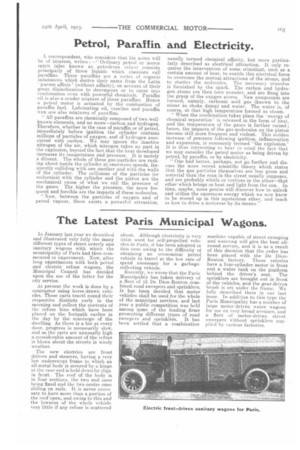Petrol, Paraffin and Electricity.
Page 17

If you've noticed an error in this article please click here to report it so we can fix it.
A correspondent, who considers that his notes will be of interest, writes : —" Ordinary petrol or motor spirit (also known as petroleum ether) consists principally of three liquids which chemists call paraffins. These paraffins are a series of organic substances which derive their name from the Latin ' parurn affinis ' (without affinity), on account of their great disinclination to decompose or to enter into combination even with powerful chemicals. Paraffin oil is also a cruder mixture of these paraffins. Hence a petrol motor is actuated by the combustion of paraffin fuel. Lubricating oil, vaseline and paraffin wax are also mixtures of paraffins.
" All paraffins are chemically composed of two wellknown elements, and no more—carbon and hydrogen. Therefore, whether in the case of paraffin or of petrol, immediately before ignition the cylinder contains millions of particles of oxygen, and of hydrogen associated with carbon. We may ignore the inactive nitrogen of the air, which nitrogen takes no part in the explosion, beyond the fact that the heat developed increases its temperature and pressure. It is merely a diluent. The whole of these gas-particles are rushing about inside the cylinder at enormous speeds, frequently colliding with one another and with the walls of the cylinder. The collisions of the particles (or molecules) with the cylinder and the piston are the mechanical cause of what we call the pressure of the gases. The higher the pressure, the more frequent and forcible are the impacts of these molecules.
" Now, between the particles of oxygen and of petrol vapour, there exists a powerful attraction,
usually termed chemical affinity, but more particularly described as electrical attraction. It only requires the intervention of some stimulant, such as a certain amount of heat, to enable this electrical force to overcome the mutual attractions of the atoms, and to shatter the molecules. The necessary stimulus is furnished by the spark. The carbon and hydrogen atoms are then torn asunder, and are flung, into the grasp of the oxygen atoms. New compounds are formed, namely, carbonic acid gas (known to the miner as choke damp) and water. The water is, of course, at that high temperature formed as steam. "When the combination takes place the 'energy of chemical separation' is released in the form of heat, and the temperature of the gases is further raised ; hence, the impacts of the gas-molecules on the piston become still more frequent and violent. This sudden increase of pressure following ignition, inflammation and expansion, is commonly termed 'the explosion.' It is thus interesting to bear in mind the fact that we may consider the petrol motor as being driven by petrol, by paraffin, or by electricity.
"One had better, perhaps, not go further and discuss the more recent scientific theory which states that the gas particles themselves are less gross and material than the man in the street usually supposes, and are probably whirls or vortices in the ether—that ether which brings us heat and light from the sun. In time, maybe, some genius will discover how to unlock and utilize the enormous energy which we now know to be stored up in this mysterious ether, and teach us how to drive a motorcar by its means."
























